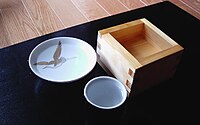
Photo from wikipedia
ABSTRACT This study examined the effect of foliar zinc (Zn) application on grain yield, Zn and phytate concentrations and its impact on the phytate:Zn molar ratio, an indicator for Zn… Click to show full abstract
ABSTRACT This study examined the effect of foliar zinc (Zn) application on grain yield, Zn and phytate concentrations and its impact on the phytate:Zn molar ratio, an indicator for Zn bioavailability in human digestive tracts, in unpolished and polished rice between two rice cultivars across two cropping years. The modern improved rice cultivar CNT1 and the traditional improved cultivar KDK were foliar applied with five rates of ZnSO4 in two cropping years. In 2016, 0.3% ZnSO4 increased the Zn concentration of unpolished rice in KDK by 21% over the nil Zn, while the effect was not found in CNT1. In polished rice, 0.2–0.4% ZnSO4 increased the Zn concentration by 11.2–20.0% in CNT1 and by 8.3–24.1% in KDK, and decreased the phytate concentration by 5.2–16.9% in KDK but not in CNT1. In 2017, 0.4% ZnSO4 increased the Zn concentration by 18.2–26.2% and 32.4–42.6% in unpolished and polished rice, respectively, in both cultivars. Application of 0.4% ZnSO4 decreased the phytate:Zn molar ratio in polished rice from 29.7 to 18.3 and from 26.4 to 17.9 in CNT1 and KDK, respectively in 2016, and from 15.7 to 12.6 in KDK in 2017. Foliar Zn application decreased the phytate:Zn molar ratio in unpolished rice from 27.9 to 22.7 and from 21.9 to 17.2 in CNT1 and KDK, respectively in 2017, but had no effect in 2016. Thus, foliar Zn application can improve grain Zn concentration and decrease the phytate:Zn molar ratio in both unpolished and polished rice but the response can vary with cropping year and cultivar. Graphical abstract
Journal Title: Plant Production Science
Year Published: 2020
Link to full text (if available)
Share on Social Media: Sign Up to like & get
recommendations!